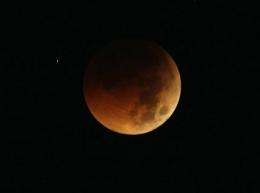The Earth completely casts its shadow over the moon in a total lunar eclipse as seen in Manila, Philippines before dawn Thursday June 16, 2011. The total lunar eclipse was also visible in most parts of Asia. (AP Photo/Bullit Marquez)
(AP) -- Asian and African night owls were treated to a lunar eclipse, and ash in the atmosphere from a Chilean volcano turned it blood red for some viewers.
The Sydney Observatory said the eclipse was to begin at 3:25 a.m. Thursday (1:25 p.m. EDT, 5:25 p.m. GMT Wednesday) and last until after 5 a.m.
Scientists said the specific phenomenon happening Thursday - known as a "deep lunar eclipse" - often exudes a coppery color. But the intensity of the color depends on the amount of ash and dust in the atmosphere.
Luckily for moon-gazers, there was plenty of ash in the air so the moon appeared orange or red, especially in Asia. Air travelers haven't been so lucky: The ash has grounded hundreds of flights around the region.
Scientists said the eclipse could be safely observed with the naked eye.
©2011 The Associated Press. All rights reserved. This material may not be published, broadcast, rewritten or redistributed.























